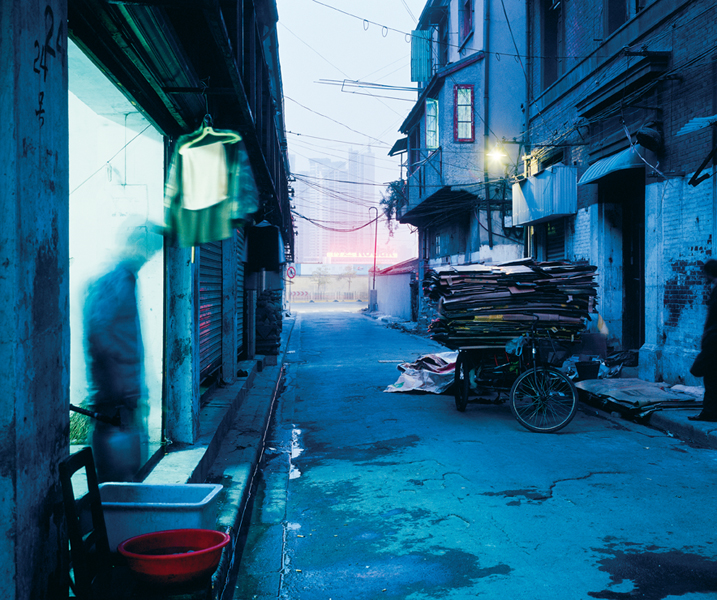[Fall 2008]
Monte Clark Gallery, Toronto
September 20 – November 18, 2007
Like those of many of his Vancouver contemporaries, Greg Girard’s photographs – melancholy, colour-drenched images of Shanghai – are very large, which has the effect of enticing the viewer into a direct relationship with the city’s grand architecture and intimate interiors. The images in the exhibition are taken from Girard’s latest book, Phantom Shanghai, and showcase China’s largest city as a dreamlike film set in the midst of a bizarre and beautiful transition.
Originally a fishing town, Shanghai is now the eighth-largest city in the world, with a population estimated at well over 13 million. Though it languished – remaining largely intact – after the Communist takeover in 1949, since 1992 it has led China’s new economic growth, resulting in a unique conflation of Old World architecture and lifestyle with the new. Girard has been based in Asia since the late 1980s, covering the region for international publications such as Time and Newsweek. In 1993, he documented the final years of the Kowloon Walled City in a book titled City of Darkness, and in 2002 he co-founded documentCHINA, a picture agency specializing in contemporary photography from China, Hong Kong, and Taiwan.
There are other photographers whose work treads the line between art and documentation – Edward Burtynsky, for example, whose imagery exploits the contrast between vision and knowledge, beauty and tragedy. Girard’s work is similarly about social and cultural contrasts, but it’s more about finding pockets of interest in the “now,” often days prior to a building’s destruction. Shooting in natural light at dusk and dawn with medium-format daylight transparency film, with exposures of thirty seconds to five minutes, Girard maintains a documentary style while imbuing his imagery with a luminosity so unusual as to be almost surreal.
In many images, apartment windows exude warm orange light, while clammy corridors are often bathed in violet tones against the harsh white or bright colours of industry. The blue-green of the damp side street in Six Hundred Things, #24 Pinghu Lu (2005), for instance, stands dramatically before a backdrop of smoky white and red neon. Off to one side, a door opens, illuminating the alley further in a greenish hue. Across the way, a single yellow bulb pierces the air. In House on Zixia Lu, #14 Zixia Lu (2005), a stunning work that wasn’t in the exhibition (but should have been), ochre light ricochets across an ancient, narrow alley lined with stacks of mirrors leaning to each side, while over top, a foreboding red light – not the red of a sunset, but the harsh red of an illuminated billboard – neatly divides the scene in two. In the introduction to the book, Girard says, “These are photographs of the Shanghai that will not survive the vision the city has for itself. That these homes, shops, lanes and buildings survived as long as they did… is by accident rather than design.”
The gallery has chosen to exhibit Girard’s more atmospheric images that tend to avoid over-sentimentalism, though they speak of Girard’s fondness for his adopted home. Former Cinema Lobby, #11 Jianguo Dong Lu (2006) is one, in which a storage area filled with blue light features a stately crystal chandelier – a reminder of more elegant times. Another, 2nd Floor, Yan Family House (2006), which shows leather shoes resting on the worn wooden floor of a migrant workers’ building, evokes the intimacy of early work by Girard’s friend, the photographer Roy Arden. The exhibition’s signature image – and the book’s cover – is House on Yuyuan Lu, #81 Yuyuan Lu (2001), an image of a decrepit house of ghostly character, abandoned on a plot of land while high-rises sprout menacingly behind. It stands, resolute and dignified, in a city that lost interest long ago.
The best works in the show are of two types: those that use different forms of light to suggest past, present, and impending future within a single image, and interior shots that speak symbolically of China’s rapid changes. Both types elucidate Girard’s desire to show Shanghai’s “lived-in-ness, the vanishing evidence of the hard flow of time through this city.” In Rags, One-Room Apartment, Liyang Lu (2005), a number of orderly, clean, but weary dishrags hang on the back of a door, and Restaurant Steps, Lunar New Year (2001) shows leftover paper firecracker remnants from a New Year’s celebration. Suggestive of the green-and-red uniforms of the Red Guard, it is a fitting allegory for a China that will carry its history forward in spirit, even as it is being destroyed.
Andrea Carson received her master’s degree in art criticism from City University (UK). Carson has curated a number of projects, including Revealed: New Canadian Video at Canada House, London (UK), in 2003. Her writing appears in exhibition catalogues and on Artnet.com, in ARTnews, Art Papers, Contemporary, Border Crossings, C magazine, Canadian Art, Toro, Videopool, and Azure, among other publications.


